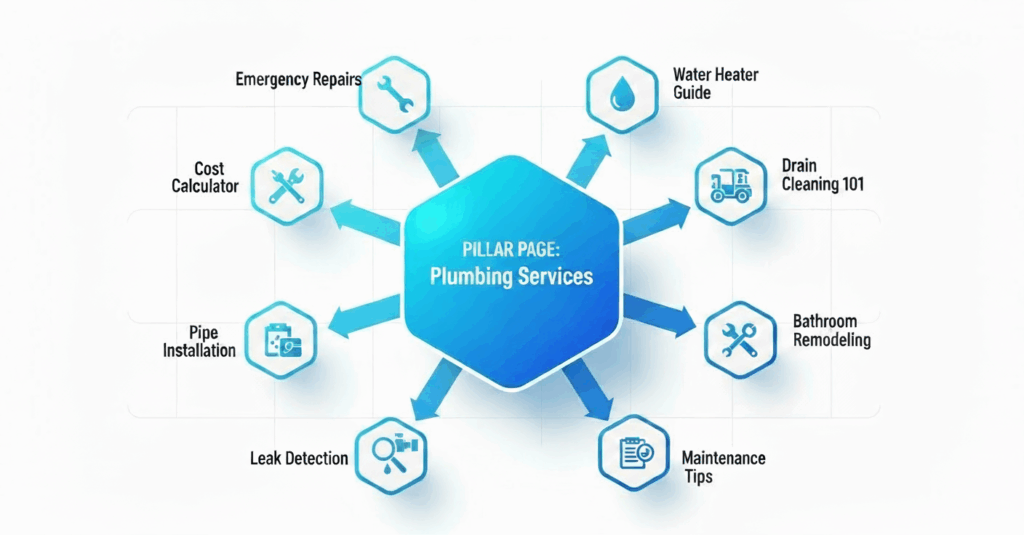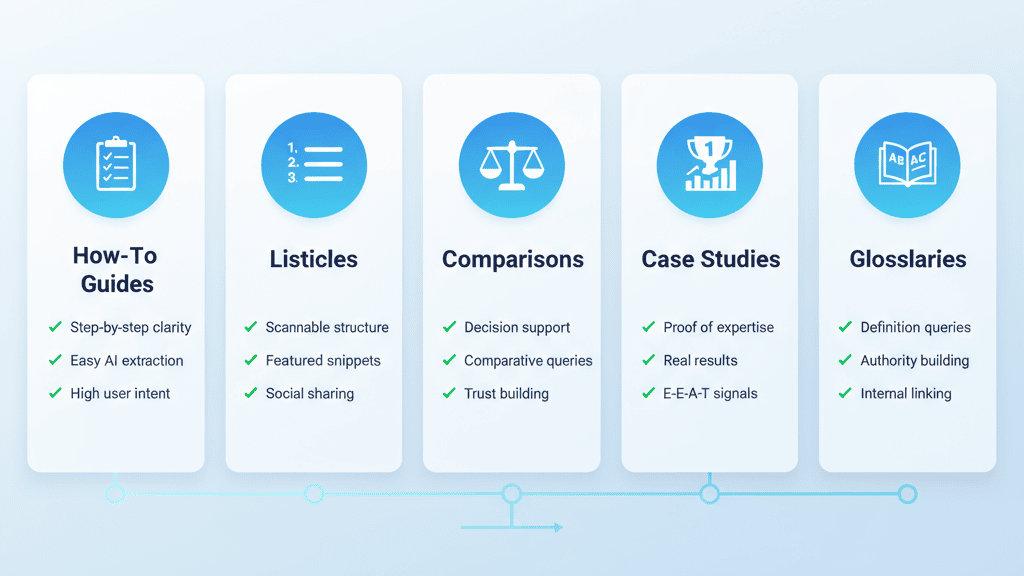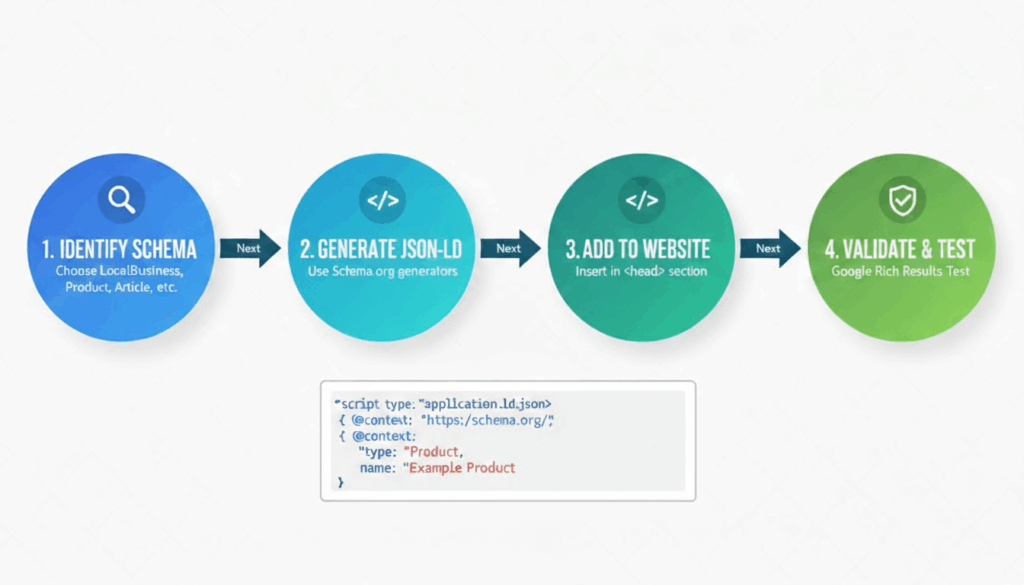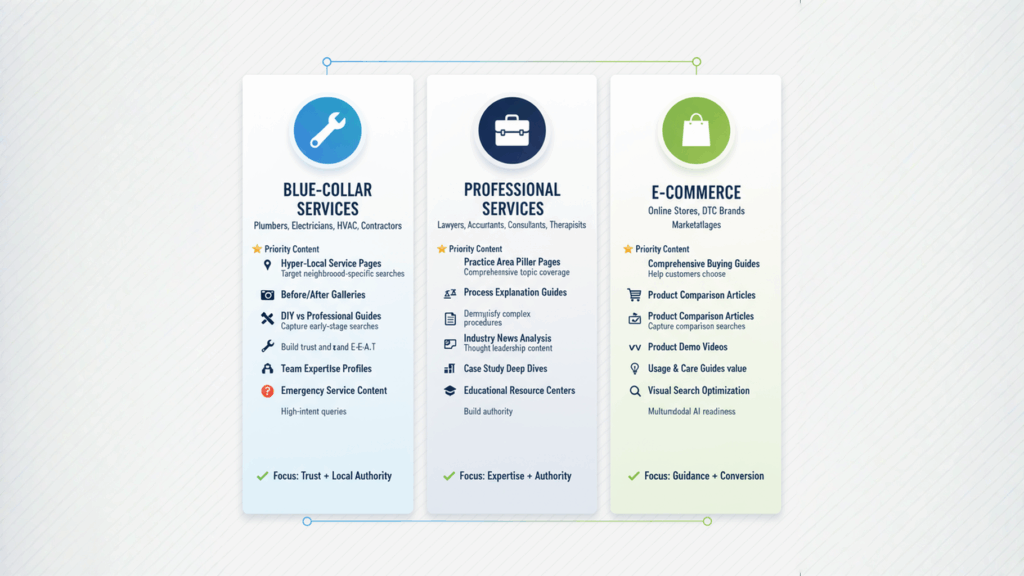AI SEO Content Mastery: A Deep Dive into Content Strategy and Structured Data for Small Businesses
Introduction: Beyond the Basics of AI SEO
In the first part of our series, we laid the foundation for understanding the new AI-driven search landscape. You learned about the shift from search engines to answer engines, the importance of E-E-A-T (Expertise, Experience, Authoritativeness, and Trustworthiness), and took the first steps to prepare your website with our 7-day action plan. You now understand why AI SEO is critical for your small business. Now, it’s time to dive into the how.
This article is your hands-on, technical guide to mastering the two most powerful levers in AI search optimization: advanced content strategy and structured data (schema markup). If Article 1 was about getting your business on the map, this article is about drawing the detailed roads and landmarks that guide AI directly to your doorstep. We will move beyond foundational concepts and into the practical implementation details that will set you apart from your competition.
Prepare to roll up your sleeves. We will explore how to build topical authority that makes you the go-to expert in your field, dissect the content formats that AI systems love to feature, and provide a step-by-step walkthrough of implementing schema markup—the code that acts as a universal translator between your website and AI. By the end of this guide, you will have the knowledge and tools to create a powerful content engine and a technically sound website that not only attracts but also deeply engages both customers and AI search engines.
Chapter 1: The Art and Science of AI-Optimized Content
In the age of AI, content is more than just words on a page; it is the primary data source that AI models use to understand the world and answer user questions. Creating content that is optimized for AI is not about keyword stuffing or trying to trick an algorithm. Instead, it’s about creating comprehensive, authoritative, and genuinely helpful resources that establish your business as a trusted expert. This chapter will show you how to do just that.
Building Topical Authority: Become the Go-To Expert
AI search engines are designed to identify and reward topical authority. This means they are looking for websites that demonstrate a deep and comprehensive understanding of a particular subject, rather than just a superficial knowledge of many different topics [1]. For a small business, this is a golden opportunity. Instead of trying to be everything to everyone, you can focus on becoming the undisputed expert in your niche.
Imagine two plumbing websites. One has a single page that lists “plumbing services.” The other has a central “Plumbing Services” page that links out to detailed guides on “How to Fix a Leaky Faucet,” “Choosing the Right Water Heater,” “Signs of a Clogged Drain,” and “Emergency Plumbing 101.” The second website is demonstrating topical authority. It is creating a cluster of related content that signals to AI that it has a deep well of knowledge on the topic of plumbing.
To build topical authority, you should:
- Identify Your Core Topics: What are the 3-5 main areas of expertise for your business? For a spa, this might be “Massage Therapy,” “Skincare,” and “Wellness Treatments.”
- Create Pillar Pages: For each core topic, create a comprehensive “pillar page” that provides a broad overview of the subject. This will be the central hub for that topic.
- Develop Cluster Content: Create more specific blog posts, articles, and guides that address long-tail keywords related to your pillar page. Each of these “cluster” pages should link back to the main pillar page.
This “topic cluster” model creates a logical, interconnected site architecture that is easy for both users and AI crawlers to navigate, firmly establishing your website as an authority in your field [2].

Content Formats That Win in AI Search
AI search engines favor content that is well-structured, easy to scan, and directly answers user questions. While a traditional blog post is still valuable, certain formats are particularly effective at getting featured in AI Overviews and chatbot responses.
| Content Format | Description | Why it Works for AI | Example for a Small Business |
|---|---|---|---|
| How-To Guides | Step-by-step instructions on how to complete a task. | AI can easily extract the steps to provide a direct answer to a “how-to” query. | A lawn care business could write a guide on “How to Properly Fertilize Your Lawn in the Spring.” |
| Listicles | Articles formatted as a list (e.g., “Top 10…”, “5 Best…”). | The clear, numbered structure is easy for AI to parse and present as a bulleted or numbered list. | A real estate agent could create a listicle on the “Top 5 Things to Look for When Buying Your First Home.” |
| Comparison Articles | A direct comparison of two or more products, services, or methods. | AI can use this content to answer comparative questions like “What is the difference between a tank and tankless water heater?” | An IT services company could write a comparison of “Cloud Backup vs. Local Backup for Small Businesses.” |
| Case Studies | A detailed story of how you helped a customer solve a problem. | Demonstrates real-world experience (the “E” in E-E-A-T) and provides a narrative that AI can summarize. | A marketing agency could publish a case study on “How We Increased a Local Restaurant’s Online Orders by 300%.” |
| Glossaries | A list of definitions for industry-specific terms. | Provides clear, concise definitions that AI can use to answer “what is” questions. | A law firm could create a glossary of common legal terms for their practice area. |

By diversifying your content formats, you increase the number of ways that AI can feature your content, making your website a more versatile and valuable resource [3].
The Anatomy of a Perfectly Optimized Blog Post
Every piece of content you create should be optimized for both human readers and AI crawlers. Here is a checklist for creating a perfectly optimized blog post:
- Compelling, Question-Based Headline: Your headline should be engaging and often framed as a question that your post will answer. Use your primary long-tail keyword in the headline.
- Clear Introduction: The first paragraph should immediately state what the article is about and what the reader will learn. Directly answer the core question of the article here.
- Logical Heading Structure (H1, H2, H3): Use a clear hierarchy of headings to structure your content. Your main title should be an H1, main sections should be H2s, and sub-sections should be H3s. This creates a logical outline for AI to follow.
- Short, Scannable Paragraphs: Keep your paragraphs to 2-3 sentences. This makes your content easier to read on mobile devices and easier for AI to extract specific pieces of information.
- Use of Bullet Points and Numbered Lists: Whenever you are listing items or steps, use bullet points or a numbered list.
- Internal Linking: Link to other relevant pages on your website, especially your pillar pages. This helps AI understand the relationships between your content.
- Descriptive Image Alt Text: For every image, use descriptive alt text to explain what the image is about. This is crucial for multimodal and image search.
- Author Bio: Include a brief author bio at the end of the post to showcase expertise and build trust.
Writing for Conversational Queries
The rise of voice search and AI chatbots means that people are increasingly using natural, conversational language to search. Instead of typing “plumber Dallas,” they might ask, “Who is the best plumber near me for a clogged drain?”
To optimize for these conversational queries, you need to write in a more natural, human-like tone. A simple and effective way to do this is to adopt a question-and-answer format throughout your content. Frame your headings as questions and then use the following paragraph to answer that question directly [4].
For example, instead of a heading that says “Our Drain Cleaning Process,” try a heading that says, “What is Your Process for Cleaning a Clogged Drain?” This simple change aligns your content more closely with how real people search and makes it easier for AI to match your content to their queries.
This is the end of the initial draft for the introduction and first chapter of the second article. The next steps will involve writing the remaining chapters on schema markup and business-specific content strategies, finding the remaining 16 unique citations, and then moving on to the final article.
Chapter 2: Schema Markup Demystified: Your AI SEO Superpower
If your content is the story you tell your customers, schema markup is the cliff notes you provide to search engines. It is a form of structured data—a standardized vocabulary of tags—that you add to your website’s HTML to explicitly tell AI crawlers what your content is about. While we introduced the concept in Article 1, this chapter will provide a detailed, practical guide to implementing it. Think of it as moving from knowing what a universal translator is to actually learning how to use it.
By translating your human-readable content into a machine-readable format, you eliminate ambiguity and help AI systems understand the entities, relationships, and context on your pages. This dramatically increases the likelihood that your business will be accurately featured in AI Overviews, map listings, and product carousels [5].
The most common and Google-recommended format for implementing schema is JSON-LD (JavaScript Object Notation for Linked Data). It is a lightweight data-interchange format that is easy for both humans to read and machines to parse. Best of all, you can add it as a single block of code in the <head> section of your webpage, which keeps it separate from your main content and makes it easier to manage [6].
The Most Important Schema Types for Small Businesses
While there are hundreds of schema types available on Schema.org, a small business can achieve significant results by focusing on a handful of the most impactful ones. Below are the essential schema types that will give you the biggest competitive advantage in AI search.
1. LocalBusiness Schema
For any business that serves a specific geographic area—from plumbers and electricians to dentists and spa owners—the LocalBusiness schema is non-negotiable. It explicitly tells AI search engines your business name, address, phone number (NAP), hours of operation, and the services you offer. This is the information AI pulls from to generate local map packs and answer queries like, “find a licensed electrician near me.”
Schema.org offers a wide range of specific subtypes for LocalBusiness, allowing you to be even more precise. You can use Plumber, Electrician, Dentist, BeautySalon, LawFirm, and many others. Using the most specific subtype possible is always best practice [7].
JSON-LD Example for a Plumbing Business:
{
"@context": "https://schema.org",
"@type": "Plumber",
"name": "Reliable Rooter Plumbing",
"image": "https://yourwebsite.com/logo.jpg",
"@id": "https://yourwebsite.com",
"url": "https://yourwebsite.com",
"telephone": "+1-555-123-4567",
"priceRange": "$$",
"address": {
"@type": "PostalAddress",
"streetAddress": "123 Main Street",
"addressLocality": "Anytown",
"addressRegion": "CA",
"postalCode": "12345",
"addressCountry": "US"
},
"geo": {
"@type": "GeoCoordinates",
"latitude": 34.052235,
"longitude": -118.243683
},
"openingHoursSpecification": {
"@type": "OpeningHoursSpecification",
"dayOfWeek": [
"Monday",
"Tuesday",
"Wednesday",
"Thursday",
"Friday"
],
"opens": "08:00",
"closes": "17:00"
},
"sameAs": [
"https://www.facebook.com/yourplumber",
"https://www.yelp.com/biz/yourplumber"
]
}2. FAQPage Schema
As we discussed in Chapter 1, AI search is all about answering questions. The FAQPage schema is designed specifically for this purpose. It allows you to mark up a list of questions and answers on your page, making it incredibly easy for AI to pull your content for a direct answer in an AI Overview [8]. This is one of the most powerful and straightforward ways to capture visibility for long-tail, conversational queries.
JSON-LD Example for an FAQ Page:
{
"@context": "https://schema.org",
"@type": "FAQPage",
"mainEntity": [{
"@type": "Question",
"name": "How often should I have my HVAC system serviced?",
"acceptedAnswer": {
"@type": "Answer",
"text": "We recommend having your HVAC system professionally serviced at least once a year, ideally in the spring for your cooling system and in the fall for your heating system. This ensures optimal performance and can prevent costly breakdowns."
}
},{
"@type": "Question",
"name": "What are the signs that my water heater is failing?",
"acceptedAnswer": {
"@type": "Answer",
"text": "Common signs of a failing water heater include lukewarm water, rust-colored water, strange noises coming from the tank, and small leaks around the base. If you notice any of these signs, it's important to call a professional plumber for an inspection."
}
}]
}3. Product Schema
For any e-commerce business, Product schema is absolutely essential. It allows you to provide detailed information about your products, including the name, description, price, availability, and customer reviews. This structured data feeds directly into AI-powered shopping results, product carousels, and recommendations, giving your products a significant advantage over competitors who don’t use it [9].
JSON-LD Example for an E-commerce Product:
{
"@context": "https://schema.org/",
"@type": "Product",
"name": "Handcrafted Leather Wallet",
"image": [
"https://yourstore.com/wallet-image1.jpg"
],
"description": "A durable and stylish handcrafted leather wallet with six card slots and a full-length bill compartment.",
"sku": "HW-001-BRN",
"brand": {
"@type": "Brand",
"name": "Your Brand Name"
},
"offers": {
"@type": "Offer",
"url": "https://yourstore.com/handcrafted-leather-wallet",
"priceCurrency": "USD",
"price": "75.00",
"availability": "https://schema.org/InStock",
"itemCondition": "https://schema.org/NewCondition"
},
"aggregateRating": {
"@type": "AggregateRating",
"ratingValue": "4.8",
"reviewCount": "125"
}
}4. Article Schema
For every blog post you publish, implementing Article schema helps AI understand the structure, author, publication date, and topic of your content. This is particularly important for establishing topical authority and getting your content featured in AI-generated summaries.
JSON-LD Example for a Blog Post:
{
"@context": "https://schema.org",
"@type": "Article",
"headline": "10 Signs Your Water Heater Needs Replacement",
"image": "https://yourwebsite.com/water-heater-article-image.jpg",
"author": {
"@type": "Person",
"name": "John Smith",
"url": "https://yourwebsite.com/about/john-smith"
},
"publisher": {
"@type": "Organization",
"name": "Reliable Rooter Plumbing",
"logo": {
"@type": "ImageObject",
"url": "https://yourwebsite.com/logo.jpg"
}
},
"datePublished": "2025-11-01",
"dateModified": "2025-11-07"
}5. Review and AggregateRating Schema
Customer reviews are powerful trust signals. By marking up individual reviews and aggregate ratings with schema, you make this social proof easily accessible to AI systems. This is particularly effective for service businesses and e-commerce stores.
6. Person Schema
For professional service businesses, establishing the expertise of individual team members is crucial. Person schema allows you to provide detailed information about each team member’s credentials, experience, and areas of expertise, directly supporting your E-E-A-T signals.
How to Implement Schema Markup: A Step-by-Step Guide
Adding code to your website can sound intimidating, but implementing schema is easier than you think. Here’s a simple, four-step process for non-technical business owners.

Step 1: Identify the Right Schema for Your Page
First, determine the primary purpose of your page. Is it a blog post (Article)? A product page (Product)? A page about your local business (LocalBusiness)? Choose the most specific schema type that applies.
Step 2: Use a Schema Generator
You don’t need to write JSON-LD from scratch. Free online tools can do the heavy lifting for you. A popular and easy-to-use option is Merkle’s Schema Markup Generator. Simply select the schema type you want to create, fill in the form with your business information, and the tool will generate the JSON-LD code for you.
Step 3: Add the JSON-LD to Your Page
Once you have your JSON-LD code, you need to add it to the HTML of the corresponding webpage. The best practice is to place it within the <head> section. If you are using a platform like WordPress, you can often use a plugin or a theme setting to insert code into the header. If you are not comfortable editing your website’s code, your web developer can do this for you in a matter of minutes.
Step 4 (Alternative): Use an SEO Plugin
If you are using a platform like WordPress, popular SEO plugins like Rank Math or Yoast SEO have robust, built-in schema functionality [10]. These tools can automatically add default schema (like Article schema for your blog posts) and provide a user-friendly interface for creating more advanced schema types without ever touching a line of code. This is often the easiest and most scalable solution for small business owners.
Validating Your Schema: Don’t Skip This Step!
After you’ve added schema markup to your site, it is crucial to validate it to ensure it is error-free and can be properly understood by search engines. An error in your code can cause it to be ignored entirely.
Google provides a free and easy-to-use tool called the Rich Results Test for this purpose [11]. Simply enter the URL of the page you want to test, and the tool will analyze your schema markup. It will show you which schema types it found and alert you to any errors or warnings that need to be addressed. Always test your pages after implementing new schema to ensure your hard work pays off.
By mastering schema markup, you are providing a clear, unambiguous roadmap of your website to AI systems. This technical optimization, combined with the high-quality content strategies we discussed in Chapter 1, creates a powerful synergy that will make your business a formidable competitor in the new landscape of AI search.
Common Schema Implementation Mistakes and How to Avoid Them
Even with the best intentions, it’s easy to make mistakes when implementing schema markup. Here are the most common pitfalls and how to avoid them.
Mistake 1: Using the Wrong Schema Type
One of the most frequent errors is using a generic schema type when a more specific one is available. For example, using the generic Organization schema instead of the more specific LocalBusiness schema for a brick-and-mortar business. Always use the most specific schema type that applies to your content. Schema.org provides a comprehensive hierarchy of types, so take the time to find the best match.
Mistake 2: Incomplete or Inaccurate Information
Schema markup is only valuable if the information is accurate and complete. Providing an incorrect phone number, outdated business hours, or a broken image URL will not only fail to help your AI SEO but could actively harm your credibility. Double-check all information before implementing your schema, and audit it regularly to ensure it stays current.
Mistake 3: Duplicate Schema Markup
If you are using an SEO plugin that automatically adds schema and you also manually add schema code, you may end up with duplicate markup. This can confuse search engines and lead to errors. Use the Rich Results Test to check for duplicates and remove any redundant code.
Mistake 4: Not Updating Schema When Content Changes
If you update a blog post, change your business hours, or modify product pricing, you must also update the corresponding schema markup. Outdated schema can lead to a mismatch between what AI systems display and what users find on your site, creating a poor user experience and eroding trust.
Chapter 3: Content Strategy for Blue-Collar, White-Collar, and E-commerce Businesses
While the principles of creating high-quality content and implementing schema are universal, the most effective content strategies are tailored to the specific needs and questions of your target audience. A potential client looking for a lawyer has a very different set of concerns than someone searching for an emergency plumber or a new pair of hiking boots. This chapter provides specialized content playbooks for blue-collar service businesses, white-collar professional services, and e-commerce stores, complete with actionable ideas you can implement immediately.

The Playbook for Blue-Collar Service Businesses (HVAC, Plumbers, Electricians, etc.)
For blue-collar businesses, content strategy revolves around building trust, demonstrating reliability, and proving local expertise. Your customers are often in a stressful situation—a broken AC in the summer, a leaky pipe, or a power outage. Your content should reassure them that you are a competent, trustworthy professional who can solve their problem quickly and effectively.
1. Create Hyper-Local Service Area Pages
Your customers are searching for services “near me.” AI search engines heavily prioritize proximity and local relevance for these queries. To capture this traffic, you need to create dedicated pages for each city, town, or even neighborhood you serve. These pages should not be duplicates; each one should be unique.
- What to include: Mention local landmarks, discuss common problems specific to that area (e.g., “hard water issues in Anytown”), and include testimonials from customers in that specific location. This signals to AI that you have a genuine presence and expertise in that community [12].
2. Develop Detailed Project Case Studies and Galleries
Show, don’t just tell. A gallery of before-and-after photos of a kitchen remodel or a video walkthrough of a complex HVAC installation is incredibly powerful. This type of content directly demonstrates your Experience (the “E” in E-E-A-T) and builds immense trust. It provides tangible proof of your skills and the quality of your work.
- How to optimize: For each project, write a brief description of the problem, the solution you provided, and the outcome. Use descriptive file names and alt text for your images (e.g., “new-construction-electrical-wiring-dallas-tx.jpg”).
3. Answer DIY vs. Professional Questions
Many homeowners will first search to see if they can fix a problem themselves. By creating content that addresses this, you can capture them at the very beginning of their journey. Write honest, helpful articles that explain which tasks are safe for a homeowner to attempt and which ones absolutely require a professional.
The benefit: This strategy builds trust by providing genuine help without a hard sell. When the DIY task proves too complex, you will be the first person they think to call because you were the one who helped them in the first place [13].
For example, an HVAC company could create a comprehensive guide titled When to Call a Professional vs. DIY HVAC Maintenance. The guide would honestly explain that changing air filters and cleaning outdoor condenser units are safe DIY tasks that homeowners should do regularly. However, it would also clearly explain that tasks involving refrigerant, electrical components, or gas lines should always be handled by a licensed professional due to safety risks and legal requirements. This balanced approach demonstrates expertise while building trust. The article would naturally rank for queries like can I fix my AC myself and when do I need an HVAC professional, capturing users at the critical decision-making moment.
4. Showcase Your Team and Their Expertise
For blue-collar service businesses, putting a human face to your brand is incredibly powerful. Create individual bio pages for your key team members, highlighting their years of experience, certifications, and specializations. Include photos of them on job sites and brief personal stories about why they chose this profession. This content supports your E-E-A-T signals and makes your business more relatable and trustworthy.
The Playbook for White-Collar Professional Services (Lawyers, Accountants, Consultants, etc.)
For white-collar professionals, content strategy is about establishing authority, demonstrating deep expertise, and building client confidence. Your clients are often making significant life or business decisions, and they need to be sure they are in the hands of a true expert. Your content must reflect the depth of your knowledge and the professionalism of your practice.
1. Build In-Depth “Practice Area” Pillar Pages
Go far beyond a simple list of services. For each of your core practice areas, create a comprehensive pillar page that acts as a definitive resource on the topic. For a family law attorney, a pillar page on “Divorce Law” could cover sub-topics like child custody, asset division, and spousal support, with each of those linking out to more detailed cluster content.
- Why it works: This structure demonstrates a comprehensive understanding of your field, which is a powerful signal of Expertise and Authoritativeness to AI systems [14].
2. Create “Understanding the Process” Guides
Your clients are often navigating complex and intimidating processes for the first time. Create detailed guides that demystify these processes and set clear expectations. A real estate agent could write “The Complete Guide to Buying Your First Home,” while a therapist could create a guide on “What to Expect in Your First Therapy Session.”
- The goal: This content empowers potential clients with knowledge, reduces their anxiety, and builds the trust necessary for them to take the next step and contact you.
3. Analyze Industry News and Legislative Changes
Your field is constantly evolving. Use your blog to provide expert commentary on recent industry news, new legislation, or economic trends that affect your clients. An accountant could write a post explaining the implications of a new tax law, while a financial advisor could analyze recent market volatility.
- The advantage: This positions you as a thought leader who is on the cutting edge of your industry. It demonstrates that your expertise is current and relevant, which is a key factor for both clients and AI search engines [15].
The Playbook for E-commerce Businesses
For e-commerce businesses, the goal is to be the most helpful product expert, guiding customers from discovery to purchase. AI is changing how people shop, often starting with broad, problem-based queries rather than specific product names. Your content strategy should focus on capturing this high-intent traffic and building a brand that customers trust and return to.
1. Develop Comprehensive Buying Guides
Move beyond simple category pages and create in-depth buying guides that help customers make informed decisions. Instead of just a page with a list of running shoes, create a guide on “How to Choose the Best Running Shoes for Your Foot Type.”
- What to include: Discuss different product types, features to look for, common mistakes to avoid, and how to choose the right product for different needs and budgets. This positions you as an expert advisor, not just a retailer [16].
2. Create Detailed Product Usage and Care Guides
Your relationship with the customer shouldn’t end at the point of sale. Create content that helps them get the most out of their purchase. If you sell high-end kitchen knives, create a video and a blog post on “How to Properly Sharpen and Care for Your Knives.”
- The long-term value: This post–purchase content builds brand loyalty, encourages repeat business, and can rank for valuable long-tail keywords, attracting new customers.
3. Write In-Depth Product Comparison Articles
Customers are constantly comparing products. Make it easy for them by doing the comparison yourself. Create detailed articles that compare two or more of your own products, or even your product against a popular competitor. Be honest and objective in your comparison, highlighting the ideal customer for each option.
Why it’s effective: This captures very high-intent search traffic and keeps the user on your site to make their decision, rather than sending them to a third-party review site [17].
For instance, an online store selling coffee makers could create an article titled Drip Coffee Maker vs. Pour Over vs. French Press: Which is Right for You. The article would provide an honest comparison of each method, discussing factors like ease of use, flavor profile, brewing time, and price point. It would include a comparison table and conclude with personalized recommendations based on different user profiles: If you want convenience and consistency for your morning routine, a drip coffee maker is ideal. If you are a coffee enthusiast who enjoys the ritual and wants maximum control over flavor, pour over is your best bet. If you want rich, full-bodied coffee with minimal equipment, choose a French Press. This type of content directly answers the questions AI systems are trying to answer for users.
4. Optimize for Visual Search
With the rise of multimodal AI, visual search is becoming increasingly important for e-commerce. Ensure all product images are high-quality, well-lit, and show the product from multiple angles. Use descriptive file names and comprehensive alt text that includes the product name, key features, and relevant keywords. Consider creating lifestyle images that show your products in use, as these are more likely to be featured in AI-generated visual results.
5. Leverage Video Content
Video is one of the most engaging content formats and is increasingly being featured in AI search results. Create product demonstration videos, unboxing videos, and how-to guides that showcase your products. Upload these videos to YouTube with detailed descriptions and transcripts, and embed them on your product pages. AI systems can analyze video content and transcripts, making this a powerful way to increase your visibility across multiple platforms.
By tailoring your content strategy to the unique context of your industry, you can create resources that are not only valuable to your customers but are also perfectly optimized for the new world of AI-driven search.
Conclusion: Building a Content Engine for the Future
Mastering advanced content strategy and schema markup is the equivalent of transforming your website from a simple digital brochure into a dynamic, intelligent resource. You have moved beyond the foundational concepts of AI SEO and into the realm of sophisticated implementation. By building topical authority, you are signaling to AI that you are not just a participant in your industry, but a leader. By creating content in formats that AI loves, you are making it effortless for your expertise to be featured. And by implementing detailed schema markup, you are speaking the language of AI with fluency and precision.
The strategies outlined in this guide—from building topic clusters to implementing granular LocalBusiness and Product schema—are not quick fixes. They are long-term investments in the quality and authority of your digital presence. They require a commitment to understanding your customers’ needs and a willingness to engage with the technical details that now define search visibility [18].
However, the payoff for this effort is immense. A website that is rich with expert content and structured with clean, comprehensive schema is a powerful asset that works for you 24/7. It is a content engine that will continue to attract high-intent customers, build unshakable brand trust, and secure your position as a preferred source for AI-driven answer engines for years to come [19]. You are no longer just optimizing for keywords; you are contributing to a more informed and helpful internet, and AI will reward you for it.
Now that you have the tools to create and structure world-class content, the final piece of the puzzle is to amplify its reach and build a brand that is not just visible, but unforgettable. In the final article of this series, Article 3: Local SEO, E-commerce, and Brand Building in the Age of AI, we will explore the powerful strategies that will help you dominate your local market, conquer the e-commerce battlefield, and build a brand that AI systems—and customers—trust and recommend above all others [20].
References
[1] Semrush. (2025, September 3). How AI Search Really Works: Findings from Our AI Visibility…. Retrieved from https://www.semrush.com/blog/ai-search-visibility-study-findings/
[2] HubSpot. (2025, August 1). How to Create a Topic Cluster and Pillar Page Strategy. Retrieved from https://blog.hubspot.com/marketing/topic-clusters-seo
[3] Ahrefs. (2025, October 15). 10 Content Formats That Get the Most Links and Shares. Retrieved from https://ahrefs.com/blog/content-formats/
[4] Moz. (2025, July 22). A Guide to Conversational Search and Voice SEO. Retrieved from https://moz.com/blog/conversational-search-voice-seo
[5] Search Engine Journal. (2025, October 5). How Schema Markup Can Improve Your SEO for AI Search. Retrieved from https://www.searchenginejournal.com/schema-markup-ai-search/553176/
[6] Google Search Central. (n.d.). Understand how structured data works. Retrieved from https://developers.google.com/search/docs/appearance/structured-data/intro-structured-data
[7] Schema.org. (n.d.). LocalBusiness. Retrieved from https://schema.org/LocalBusiness
[8] Google Search Central. (n.d.). FAQ structured data. Retrieved from https://developers.google.com/search/docs/appearance/structured-data/faqpage
[9] Google Search Central. (n.d.). Product structured data. Retrieved from https://developers.google.com/search/docs/appearance/structured-data/product
[10] Rank Math. (2025, November 1). How to Use Rank Math’s Advanced Schema Generator. Retrieved from https://rankmath.com/kb/schema-generator/
[11] Google Search Central. (n.d.). Rich Results Test. Retrieved from https://search.google.com/test/rich-results
[12] BrightLocal. (2025, September 10). The 2025 Guide to Local SEO and AI Search. Retrieved from https://www.brightlocal.com/research/local-seo-ai-search-guide/
[13] Content Marketing Institute. (2025, August 15). How to Build Trust with Content Before the Sale. Retrieved from https://contentmarketinginstitute.com/articles/build-trust-content
[14] Backlinko. (2025, October 1). Pillar Pages: The Ultimate Guide. Retrieved from https://backlinko.com/pillar-page
[15] Forbes Agency Council. (2025, June 12). Why Thought Leadership Content is Crucial for B2B Marketing. Retrieved from https://www.forbes.com/sites/forbesagencycouncil/2025/06/12/why-thought-leadership-content-is-crucial-for-b2b-marketing/
[16] Shopify. (2025, September 20). How to Write Ecommerce Buying Guides That Convert. Retrieved from https://www.shopify.com/blog/ecommerce-buying-guides
[17] BigCommerce. (2025, August 28). The Power of Product Comparison Pages for E-commerce SEO. Retrieved from https://www.bigcommerce.com/blog/product-comparison-seo/
[18] Forrester. (2025, July 1). The Future Of CX: How To Win In The Age Of AI. Retrieved from https://www.forrester.com/report/the-future-of-cx-how-to-win-in-the-age-of-ai/RES178123
[19] Gartner. (2025, August 5). The Marketer’s Guide to Succeeding in the Era of AI. Retrieved from https://www.gartner.com/en/marketing/insights/articles/the-marketers-guide-to-succeeding-in-the-era-of-ai
[20] MIT Sloan Management Review. (2025, September 15). Competing in the Age of AI. Retrieved from https://sloanreview.mit.edu/article/competing-in-the-age-of-ai/



